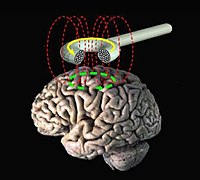
Photo from wikipedia
BACKGROUND Muscle weakness in patients with chronic stroke is due to neuromuscular disorders such as muscle atrophy, loss of voluntary activation or weak muscle contractile properties which are majored by… Click to show full abstract
BACKGROUND Muscle weakness in patients with chronic stroke is due to neuromuscular disorders such as muscle atrophy, loss of voluntary activation or weak muscle contractile properties which are majored by the imbalance of interhemispheric inhibition following stroke. In patients with chronic stroke, unilateral transcranial direct current stimulation improved the maximal isometric strength of paretic knee extensors, but bilateral transcranial direct current stimulation failed to improve concentric strength. This study aimed to assess if a bilateral current stimulation improves isometric maximal strength, voluntary activation and contractile properties of knee extensors in patients with chronic stroke. METHODS Thirteen patients with chronic stroke and eight young healthy individuals participated in this randomized, simple-blinded, crossover study that included two experimental sessions: one with sham bilateral transcranial direct current stimulation and another with effective bilateral transcranial direct current stimulation (20 min, 2 mA). In the stroke patients, the anode was placed over the primary motor cortex of the affected hemisphere and the cathode over the contralateral primary motor cortex. In healthy participants, the brain side targeted by the anode and the cathode was randomly assigned. In each session, participants performed three assessments of strength, voluntary activation and contractile properties: before, during and after effective/sham bilateral transcranial direct current stimulation. FINDINGS Bilateral transcranial direct current stimulation had no effect on any neuromuscular assessments in both groups (All P values > 0.05, partial eta-squares varied from 0.02 to 0.06). INTERPRETATION A single session of bilateral transcranial direct current stimulation did not compensate muscular weakness of knee extensors in patients with chronic stroke.
Journal Title: Clinical biomechanics
Year Published: 2019
Link to full text (if available)
Share on Social Media: Sign Up to like & get
recommendations!